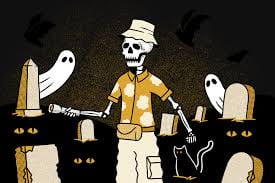
Ghost stories are an extremely popular form of entertainment and even education. Many historical sites give ghost tours and authors compile all the tales of specific areas to publish in one collection. This is especially true during the month of October and Halloween when we feel closer to the supernatural. Archaeologists work with ruins, remains, and up close and personal with the ghosts of these stories. Many of us have likely been asks if we have seen a ghost or what was the most haunted place we worked and have told our best creepy tale in response. Ghost stories and archaeology can work hand in hand and often do. April Beisaw in her 2016 paper Historical Archaeology as Ghost Hunting discusses the idea of our interactions with ‘ghosts of place’. These are not your typical ghosts that pop out and say “BOO” but are the memories and phenomena attached to a particular place. The excavations and research conducted by archaeologists are able to bring the ghosts of places to the present and inform the public about their existence.
Ghost hunting can also be used to teach history.

Ghost stories tell the same stories that archaeologists do. Neither tales contain all the information and leave plenty of holes, specifically names, dates, and other specifics. For example, we are excavating a set of ruins. We can tell that they were a house, likely during X time period, and were inhabited by this culture. Likewise ghost stories have a house where a person died which was followed by a series of events when now led to the haunting. Most of those stories are based in reality which archaeologists can help to find. Archaeologists as storytellers and truth seekers bring memories and ghosts from the past into the present. Along with the physical remains of things the ghosts left behind the ethnographies we rely on are also their own form of ghost stories. While not always about ‘ghosts’ (memories of people) they are always about phenomenological ghosts like previous traditions and ways of life. Memory is a form of ghost because it is the past which is in the present.
Using ghost hunting to educate the public is a great way to gain interest and make a lasting impression. Such tours (mostly of historical sites) engage the public by used their interest in the paranormal. But those tours also have a wealth of information about the sites. The histories of the site are just as important to the tour and the visitors as the actual ghosts. Without the backstory, the ghost doesn’t exist. Archaeology can be difficult to communicate to the public and more often than not, people go straight to the paranormal and morbid questions. So why not use that interest to our advantage. The haunted Native American burial ground that people like to talk about can be explained by archaeologists and its importance can be better communicated through the cultural background and the who, why, how, and when. The stories with the best reactions are always those that involve something creepy and unexplainable. There will always be those things that cannot be explained, and ghost stories allow for those holes to remain. In those cases, it is important that a person died in a specific room and less important to know their name or date of death. The event can tell a story and can feel much more acceptable when told as a story instead of a fact. Just remember if you are going ghost hunting as for permission first.
Archaeologists ‘hunt’ ghosts of places and tell their stories.
For an interesting podcast about this topic check out here
Follow IUP Archaeology on Facebook, Twitter, and Instagram

great post